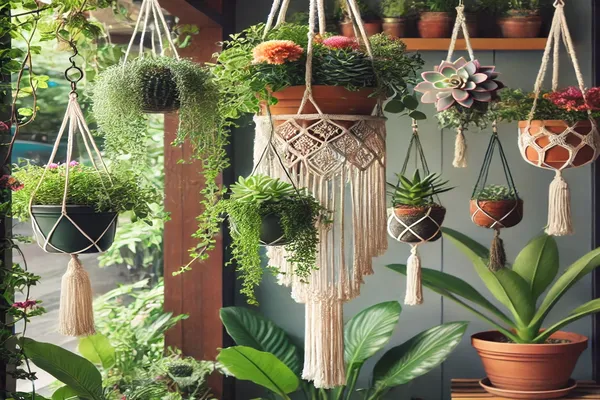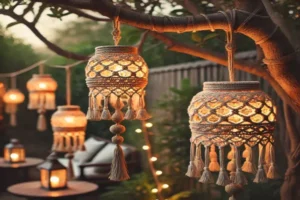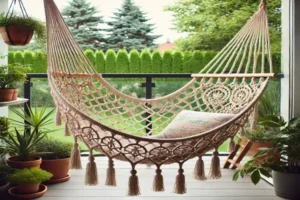Introduction
Creating a green oasis within your home has become a popular trend, especially for those living in urban spaces with limited outdoor areas. Hanging gardens offer a unique solution to incorporate nature into your living space without taking up valuable floor area. One of the most effective and aesthetically pleasing ways to achieve this is through macramé. This ancient craft not only adds a touch of bohemian elegance to your home but also serves as a functional way to suspend your plants, bringing life and greenery into your surroundings.
The versatility of macramé makes it an excellent choice for hanging gardens, allowing you to customize patterns and designs that suit your personal style and the specific needs of your plants. In this article, we will explore various “hanginggardenideas” that incorporate macramé, providing you with practical tips and creative inspiration to transform any space into a green sanctuary.
Creating a macramé hanging garden at home is a beautiful and creative way to bring greenery into your living space. Whether you have a small apartment or a spacious home, a hanging garden can transform any area into a lush, green oasis. This guide will take you through the process, from choosing the right plants to making your own macramé hangers and finding the perfect spot for your garden.
Why Choose Macramé for Your Hanging Garden?
Macramé offers a unique aesthetic appeal that effortlessly blends natural beauty with a bohemian vibe, making it a perfect choice for enhancing your hanging garden. The intricate knotting techniques used in macramé create visually stunning plant hangers that add texture and warmth to any space. Whether your home décor leans towards minimalism or embraces a more eclectic style, macramé can be tailored to suit your preferences.
One of the great advantages of macramé is its versatility. You can customize the design, color, and size of your plant hangers to complement your home’s interior or exterior. From simple, understated patterns to more elaborate and decorative designs, macramé allows you to create plant hangers that not only support your greenery but also act as a decorative statement.
In addition to its aesthetic qualities, macramé plant hangers are known for their durability. Made from strong, natural fibers like cotton or jute, these hangers can securely hold a variety of plant pots, ensuring your plants are safe and well-supported. This combination of beauty, customization, and practicality makes macramé an excellent choice for anyone looking to create a hanging garden that is both functional and stylish.
Selecting the Right Plants for Your Macramé Hanging Garden
Choosing the right plants is crucial to creating a thriving macramé hanging garden. Certain plants naturally lend themselves to hanging displays due to their growth patterns and care needs. Trailing plants, such as pothos, string of pearls, and ivy, are ideal choices as they cascade beautifully from the hangers, creating a lush and dynamic display. Succulents like burro’s tail or string of bananas are also excellent options for hanging gardens, especially in areas with abundant light. Ferns, with their delicate and feathery foliage, add a soft, elegant touch to any macramé setup.
When selecting plants, consider their specific light requirements. For example, if your hanging garden will be placed in a bright, sunny spot, opt for sun-loving plants like succulents and cacti. On the other hand, low-light areas are perfect for plants like ferns and spider plants, which can thrive with less sunlight. Watering needs are another important factor; plants that prefer similar moisture levels should be grouped together to simplify care. Additionally, think about the available space—ensure that your chosen plants have enough room to grow without becoming overcrowded.
To create a cohesive and visually pleasing look, choose plants that complement each other in terms of color, texture, and size. Combining different shades of green with varying leaf shapes can add depth and interest to your hanging garden. For example, pairing the thick, glossy leaves of a philodendron with the fine, delicate fronds of a maidenhair fern can create a beautiful contrast. By carefully selecting plants that work well together, you can design a macramé hanging garden that is not only vibrant and healthy but also aesthetically harmonious.
Creating Your Own Macramé Plant Hangers
Making your own macramé plant hangers is a rewarding and creative project that can add a personal touch to your hanging garden. Here’s a simple step-by-step guide to get you started:
Gather Your Materials
To begin, you’ll need the following materials:
- Macramé cord (cotton or jute)
- A ring (wooden or metal) for hanging
- Scissors
- Measuring tape
- Optional: Beads or other decorative elements
Cut the Cord
Cut several lengths of cord, typically around six to eight pieces, each about five times the desired finished length of your hanger. This will give you enough material to create the knots and allow for trimming at the end.
Attach the Cord to the Ring
Fold each cord in half and attach them to the ring using a lark’s head knot. To do this, loop the folded end of the cord over the ring, pull the loose ends through the loop, and tighten.
Start Knotting
Begin with a basic square knot, which is one of the most fundamental macramé knots:
- Divide the cords into groups of four.
- Take the left cord (cord A) and cross it over the two middle cords (cords B and C) and under the right cord (cord D).
- Take cord D, pass it under the middle cords, and bring it up through the loop created by cord A.
- Pull both cords A and D to tighten the knot.
- Repeat this process, but start with cord D crossing over cord A to complete the square knot.
Create the Basket
To create the basket for your pot, use a series of square knots or half knots, leaving space between each set to allow for the pot to sit securely. You can also add beads or other decorative elements as you work.
Finish the Hanger
Once your knots reach the desired length, gather all the cords together and tie a large knot at the bottom. Trim the ends to your preferred length, and your macramé plant hanger is ready to use!
Variations and Designs
There are endless variations you can try with macramé plant hangers. For a more intricate design, experiment with different knots like the spiral knot or use multiple layers of knots for added texture. You can also adjust the spacing between knots to accommodate different pot sizes or create a tiered hanger that holds multiple plants. By playing with cord thickness, color, and adding decorative elements like beads or tassels, you can customize each hanger to perfectly suit your space and plant selection.
Hanging Garden Placement Ideas
Finding the perfect spot for your macramé hanging garden can make all the difference in creating a lush, green oasis in your home. Whether you’re planning to hang your garden indoors or outdoors, the placement should enhance both the beauty of the plants and their ability to thrive.
Indoor Placement Ideas
For indoor spaces, consider hanging your macramé garden near windows where your plants can receive ample natural light. South-facing windows are ideal for sun-loving plants, while east or west-facing windows offer gentler light suitable for a broader range of species. If you’re short on space, look for vertical opportunities—like the corner of a room, above furniture, or even from the ceiling in a cascading arrangement.
Creative Placement Options
Don’t limit yourself to traditional spaces. Macramé hanging gardens can add a touch of nature to unexpected areas of your home. For example, hanging plants in the kitchen not only adds freshness but can also be functional if you choose herbs like basil or thyme. In the bathroom, humidity-loving plants such as ferns and pothos thrive and create a spa-like atmosphere. Balconies and patios are also excellent outdoor options, where you can create a green sanctuary with trailing vines and blooming flowers.
Maximizing Space and Light
To ensure your plants get the most out of their environment, think about the light exposure and airflow in each location. If you’re hanging your garden in a low-light area, consider using grow lights to supplement natural light. For outdoor hanging gardens, be mindful of wind exposure—securely fasten your macramé hangers to prevent them from swaying or falling. Additionally, rotating your plants occasionally ensures even light distribution, which promotes healthy growth.
By carefully selecting the placement for your macramé hanging garden, you can create a vibrant, thriving display that enhances your living space, both indoors and out.
Maintaining Your Macramé Hanging Garden
Keeping your macramé hanging garden healthy and vibrant requires regular care and attention, both for the plants and the hangers themselves. With the right maintenance routine, you can enjoy a lush, thriving garden that enhances your space for years to come.
Caring for Your Plants
Watering is one of the most important aspects of maintaining a hanging garden. Since hanging plants tend to dry out more quickly than those on the ground, it’s essential to monitor their moisture levels closely. Water your plants when the top inch of soil feels dry, ensuring the water drains fully to avoid root rot. Pruning is also crucial; regularly trim dead or overgrown leaves to encourage new growth and maintain the plant’s shape. Feeding your plants with a balanced liquid fertilizer every few weeks during the growing season will provide the nutrients they need to thrive.
Maintaining the Macramé Hangers
Macramé hangers are not only decorative but also functional, so it’s important to keep them in good condition. Over time, dust and dirt can accumulate on the cords, especially if your garden is indoors. To clean the hangers, gently hand wash them with mild soap and water, then hang them to air dry. Regularly check the cords for signs of wear, such as fraying or weakening knots, and repair or replace them as needed to ensure the safety of your plants.
Refreshing and Updating Your Hanging Garden
To keep your hanging garden looking fresh and interesting, consider updating it with the seasons. Swap out plants that are past their prime for new ones, or try incorporating seasonal blooms for a splash of color. You can also refresh the look of your garden by experimenting with different macramé designs, adding new decorative elements like beads or tassels, or changing the arrangement of the hangers to create a new visual effect. By periodically updating your hanging garden, you can keep it dynamic and engaging all year round.
Conclusion
Creating a macramé hanging garden at home offers a perfect blend of beauty, functionality, and creativity. By incorporating natural materials and greenery into your space, you can transform any room or outdoor area into a serene, inviting oasis. Macramé plant hangers provide a versatile and durable way to display your plants while adding a touch of handmade artistry to your décor.
With the tips and ideas provided throughout this guide, you now have the knowledge to start your own macramé hanging garden. Whether you’re selecting the perfect plants, crafting your own hangers, or finding the ideal spot to showcase your greenery, the possibilities are endless.
We encourage you to embark on this creative journey and share your hanging garden projects with others. Use the hashtag #MyMacrameGarden to showcase your unique designs and inspire a community of plant lovers and DIY enthusiasts. Happy gardening!




